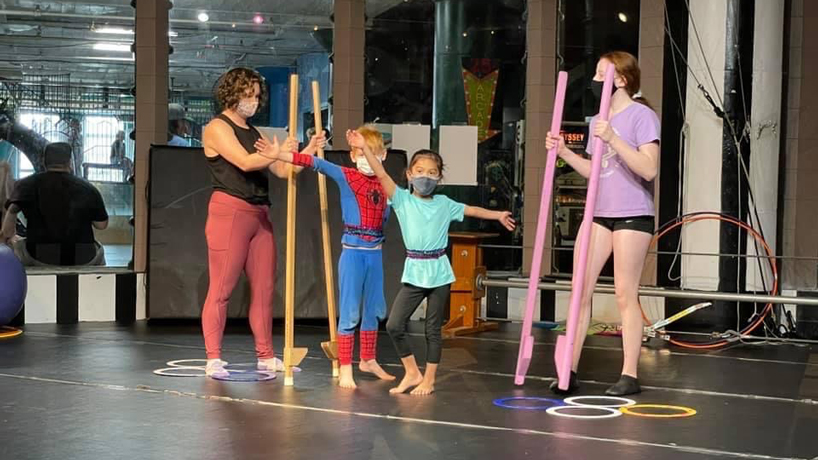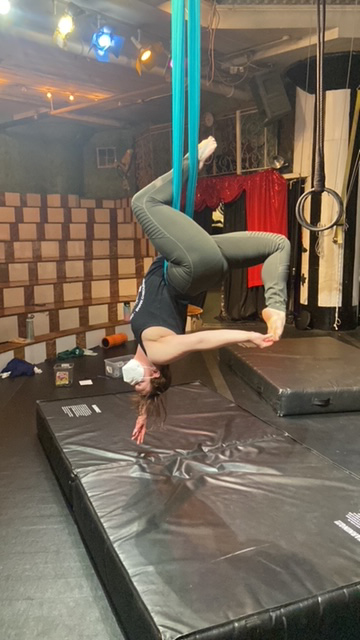
Madeleine Trotier (left), an UMSL College of Education graduate, uses her acrobatic and dance training to inform and inspire the youth of St. Louis with Circus Harmony. The nonprofit social circus uses the art of the circus performance to help children realize their creativity while teaching them perseverance, focus and teamwork. (Photos courtesy of Madeleine Trotier)
When Madeleine Trotier was diagnosed with cancer as a college student, dance was her only respite.
“While I was going through treatment, the only thing that I was able to continue with was teaching dance at a local dance studio,” she said. “That was the one thing I had during treatment. When it came time to go back to school, I decided I wanted to do education.”
After beating the disease, it’s fitting that Trotier is using her acrobatic and dance training and a BES degree from the University of Missouri–St. Louis College of Education to inform and inspire the youth of St. Louis as a coach and educator with Circus Harmony.
The nonprofit social circus is housed in the City Museum and uses the art of the circus performance to help children realize their creativity while teaching them perseverance, focus and teamwork.
Juggling dance, school and a serious illness hasn’t always been easy, but it’s led to a unique and rewarding career.
Trotier has been a dancer since she was 3 years old – something that runs in her family.
“My grandma was a ballet dancer when she was a kid, so as soon as I was old enough to take classes, she bought a dance bag and was like, ‘This is what we’re doing,’” Trotier said. “I loved it. As a kid you’re given a tutu and the ability to run around in a classroom, so of course you’re going to have fun with it. I tried a couple of other sports, and none of them stuck. I kept doing more and more ballet as I got older.”
When she was 12, she had the opportunity to work with the revered Moscow Ballet.
The company tours its “Great Russian Nutcracker” show every holiday season, but it doesn’t travel with dancers for smaller roles. Instead, the company auditions dance students in each city to fill roles in the production. Trotier earned a spot in the St. Louis show two consecutive seasons.
After high school, Trotier enrolled in the pre-med program at Rockhurst University in Kansas City, Missouri, where she also competed on the university’s dance team. During her first semester, a volunteer project at a community arts school led to her first teaching position.
She began leading tumbling classes for kids and started to learn tumbling and acrobatic dance – a blend of contemporary ballet and acrobatics – herself. Eventually, she added higher-level skills such as contortion and hand balancing to her repertoire.
Halfway through her undergraduate program, Trotier became ill. She returned to St. Louis to be closer to her family and enrolled at UMSL to continue her studies. However, a week into classes, her doctors delivered heartbreaking news.
She had cancer.
Trotier withdrew from school due to the demands of her treatment. Despite the adversity, teaching dance classes remained a positive force in her day-to-day life and gave her a newfound sense of purpose.
Trotier enrolled at UMSL after entering remission, drawn to the College of Education’s reputation and high-quality programs. She decided to pursue a BES degree because the program specializes in preparing educators who want to teach outside of a traditional classroom.
Several faculty and staff members were instrumental in helping Trotier transition back to classes, which was especially challenging amid the ongoing COVID-19 pandemic.
Ellen Duncan, an academic advisor in the College of Education Advising Office, was incredibly caring and helped Trotier feel connected to the campus while taking mostly online classes. Erika Rose, student support specialist in the Office of Clinical Experience and Partnerships, was also supportive and navigated the graduation process with her.
Pamela Blair-Bruce, BES supervisor and clinical educator, inspired Trotier, as well.
Madeleine Trotier performs an aerial acrobatic maneuver. She learned skills such as aerial acrobatics, contortion and hand balancing while teaching tumbling classes.
“I took interpretation as one of the first classes coming back, and it was such a cool class,” Trotier said. “It really changed my perspective on what education could be, and I love the way that she approached the class.”
Simultaneously, Trotier began gaining professional experience with Circus Harmony. She was looking for a way to stay connected to dance and acrobatics as she finished her degree because they were such sources of comfort during her recovery.
In September 2020, she emailed Jessica Hentoff, founder and executive director of Circus Harmony, out of the blue to inquire about a job.
“I really connected with their mission,” Trotier said. “That’s what I believe arts education should be. It should be more about ways to help students connect with the world around them and understanding themselves through a creative lens.”
Hentoff hired Trotier as an administrative intern, and in that role, she assisted the Circus Harmony staff with grant writing. After a few months, she also began teaching an online dance class for advanced students. The experience kept Trotier connected to her passion and provided an opportunity to learn about the administrative and curricular sides of an arts education organization.
Upon graduating this past December, Trotier parlayed her internship into a full-time position with Circus Harmony as a development manager and coach.
The organization runs several programs that use the basics of circus performance – acrobatics, balancing, clowning and juggling – to teach a variety of subjects and also to motivate social change. It runs regular in-person classes and a summer camp at the City Museum but also puts an emphasis on outreach to children in the St. Louis area who don’t have easy access to arts education.
Trotier is a teacher for the Circus Science program, which uses circus education to demonstrate STEM concepts to students. For instance, Trotier uses acrobatics to discuss physics and spinning plates to explore how light travels. She explained that the integration of arts into STEM classes gives students the opportunity to review and approach what they’ve learned on paper in a different way.
“When you’re moving with the material, I think that it gives kids a chance to really have that physical experience,” Trotier said. “I can feel how this centripetal force could affect me when I move. When I’m moving my arm, I can identify what muscles are doing it. The act of experiencing those things helps them connect with that more than simply writing it down. Also, with the way that school is structured, kids are sitting at a desk for eight hours a day, and no one can focus in like that.”
She’s also working with a new program called Architecture and Acrobats, which includes outreach classes in north St. Louis neighborhoods.
“We have a performance aspect where we partner our advanced kids with the local kids to create shows that tell the story of architectural sites in north St. Louis to talk about the history behind them, the importance and the significance of them,” Trotier said.
The classes give kids agency over their learning and encourage them to connect with the subject matter in a way that stems from their own interest and creativity. Trotier said they also help kids develop social emotional skills and create community bonds.
That’s why she’s excited to continue furthering Circus Harmony’s mission.
“I’m proud to work there,” Trotier said. “I think that this kind of model for education is really what’s the future for the way that we approach arts in learning and the importance of arts in schools. I’m excited about it, and I think it’s a special way for kids to connect with their learning. It’s important to put the kid first in their learning.”















